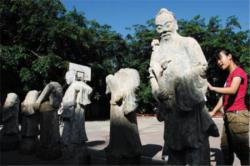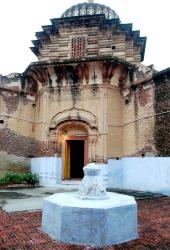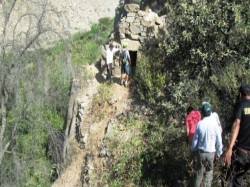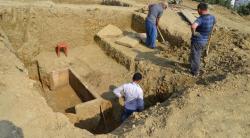INSTITUT SUPERIEUR D'ANTHROPOLOGIE
INSTITUTE OF ANTHROPOLOGY
ONLINE COURSES / COURS A DISTANCE
FALL TERM : OCTOBER 2015
REGISTER NOW
CHINE –  Xisha - A Chinese archaeological team has wrapped up its underwater excavation in the Xisha archipelago in the South China Sea, with scores of relics uncovered and several surveys conducted, local authorities said Monday. The team returned to Qinglan Port, Wenchang City, Hainan Province, on Monday after a 40-day mission, according to team leader Deng Qijiang. During the mission, a total of 37 items were retrieved from a shipwreck site near the Shanhu Island, including stone building material and shattered porcelain, although no ship was found, Deng said. The team also carried out a survey on land at ruins on Ganquan Island, and an underwater survey on another sunken ship around Jinyin Island. A team of archaeologists set off last month to excavate a shipwreck in the Xisha archipelago in the South China Sea. And besides the stone building materials they found a few days ago, seven stone statues are the latest discovery there.
Xisha - A Chinese archaeological team has wrapped up its underwater excavation in the Xisha archipelago in the South China Sea, with scores of relics uncovered and several surveys conducted, local authorities said Monday. The team returned to Qinglan Port, Wenchang City, Hainan Province, on Monday after a 40-day mission, according to team leader Deng Qijiang. During the mission, a total of 37 items were retrieved from a shipwreck site near the Shanhu Island, including stone building material and shattered porcelain, although no ship was found, Deng said. The team also carried out a survey on land at ruins on Ganquan Island, and an underwater survey on another sunken ship around Jinyin Island. A team of archaeologists set off last month to excavate a shipwreck in the Xisha archipelago in the South China Sea. And besides the stone building materials they found a few days ago, seven stone statues are the latest discovery there.
http://www.ecns.cn/2015/05-26/166783.shtml
CANADA –  Grand Pré - All of the buildings located in the Acadian village of Grand Pré were burned in 1755, so finding any trace is a huge challenge. This spring, something termed a ‘massive anomaly’ - a large underground deviation - was discovered. It might have been a structure and is one of seven that have been uncovered through archeological fieldwork. Last year's work in the orchard revealed the ruins of at least one Acadian structure, probably a house, in the area of the historic site. The students employed high-tech geophysical sensing equipment, called Geonics EM38B, to see beneath the soil, Fowler said. They then conducted small-scale excavations to examine areas of archaeological interest. He believes the Acadian village stretched for about four kilometers, so there is much of the modern landscape to survey. One of the main objectives of the archaeological work has been to locate the foundations of Saint-Charles-des-Mines Church.
Grand Pré - All of the buildings located in the Acadian village of Grand Pré were burned in 1755, so finding any trace is a huge challenge. This spring, something termed a ‘massive anomaly’ - a large underground deviation - was discovered. It might have been a structure and is one of seven that have been uncovered through archeological fieldwork. Last year's work in the orchard revealed the ruins of at least one Acadian structure, probably a house, in the area of the historic site. The students employed high-tech geophysical sensing equipment, called Geonics EM38B, to see beneath the soil, Fowler said. They then conducted small-scale excavations to examine areas of archaeological interest. He believes the Acadian village stretched for about four kilometers, so there is much of the modern landscape to survey. One of the main objectives of the archaeological work has been to locate the foundations of Saint-Charles-des-Mines Church.
http://www.novanewsnow.com/News/Local/2015-05-25/article-4155693/Field-school%3A-Students-searching-for-traces-of-the-past-in-Grand-Pre/1
INDE –  Fatehgarh Churian - The latest casualty is the historic Panj Mandir, located in Fatehgarh Churian of Gurdaspur district. The owner of this over 180-year-old temple has recklessly whitewashed lower half portion of its walls, damaging the rare frescos that adorned these. The temple was constructed by daughter-in-law of legendary Sikh ruler Maharaja Ranjit Singh, Chand Kaur, who belonged to Kanhaiya Misl. She was an ardent worshipper of Hindu deities.
Fatehgarh Churian - The latest casualty is the historic Panj Mandir, located in Fatehgarh Churian of Gurdaspur district. The owner of this over 180-year-old temple has recklessly whitewashed lower half portion of its walls, damaging the rare frescos that adorned these. The temple was constructed by daughter-in-law of legendary Sikh ruler Maharaja Ranjit Singh, Chand Kaur, who belonged to Kanhaiya Misl. She was an ardent worshipper of Hindu deities.
http://www.tribuneindia.com/news/punjab/gurdaspur-temple-s-frescoes-ruined-its-takeover-caught-in-red-tape/84955.html
INDE –  Madurai - Many significant places of archaeology, which could throw light into the past of Madurai, are disappearing, courtesy development work that has been going on in the region at a fast pace. The Archaeological Excavation Branch, VI, from Bangalore who undertook the excavation work at Keeladi in Sivaganga near Madurai found that a number of archaeological sites identified earlier along the Vaigai have disappeared due to natural and man-made reasons. The department carried out a problem-oriented exploration programme in 2013-14 and identified 239 sites along the Vaigai Valley. According to the findings, these sites could besources of various ancient remains Many of these sites face threat of being destroyed due to agricultural expansion and rapid urbanisation. Keeladi is one of the remaining sites found to have potential archaeological wealth. The site may provide evidence to understanding the missing links in the period from Iron Age to the early historic period and subsequent cultural development that took place in the region, said superintending archaeologist K Amarnath Ramakrishna, who heads the excavation team at Keeladi. Assistant archaeologist M Rajesh said he witnessed two important sites in Theni disappearing due to granite quarrying and farming. "A site at Uthamapuram in Theni was found to have a hoard of Roman coins, but they vanished due to heavy encroachment. The site was also ruined due to grape farming in the area," he said. Another important site at Poompatti in Theni disappeared due to indiscriminate granite quarrying.
Madurai - Many significant places of archaeology, which could throw light into the past of Madurai, are disappearing, courtesy development work that has been going on in the region at a fast pace. The Archaeological Excavation Branch, VI, from Bangalore who undertook the excavation work at Keeladi in Sivaganga near Madurai found that a number of archaeological sites identified earlier along the Vaigai have disappeared due to natural and man-made reasons. The department carried out a problem-oriented exploration programme in 2013-14 and identified 239 sites along the Vaigai Valley. According to the findings, these sites could besources of various ancient remains Many of these sites face threat of being destroyed due to agricultural expansion and rapid urbanisation. Keeladi is one of the remaining sites found to have potential archaeological wealth. The site may provide evidence to understanding the missing links in the period from Iron Age to the early historic period and subsequent cultural development that took place in the region, said superintending archaeologist K Amarnath Ramakrishna, who heads the excavation team at Keeladi. Assistant archaeologist M Rajesh said he witnessed two important sites in Theni disappearing due to granite quarrying and farming. "A site at Uthamapuram in Theni was found to have a hoard of Roman coins, but they vanished due to heavy encroachment. The site was also ruined due to grape farming in the area," he said. Another important site at Poompatti in Theni disappeared due to indiscriminate granite quarrying.
http://timesofindia.indiatimes.com/city/madurai/Quarrying-farming-destroy-ancient-sites/articleshow/47409670.cms
PEROU –  Chimbote - Residents and officials of the Moro district, inland from Chimbote, believe they have found a pre-Inca tomb with unique properties. Engineer Ramon Cribillero Almonds who led the team that made the discovery consulted with archaeologist Carlos Ciriaco Cacha, who confirmed that the site is a tomb, Andina reports. Archaeologists say that most pre-Hispanic burials took place underground and this is the first evidence of a tomb above ground. The discovery was made during roadworks to improve tourist access to the Huaracurana waterfall, although the it seems that locals have known of the site for some time. The construction, which is hard to get to and sits high on a hillside near the village of San Felix, comprises a portico at the entrance, about 1.5 by 1 metres, with three compartments inside. Residents of San Felix say that the rooms once contained skeletal remains. Several other pre-Inca sites in the area have suffered heavy weathering during El Niño events, as well as earth tremors. This one, however, appears to be well preserved.
Chimbote - Residents and officials of the Moro district, inland from Chimbote, believe they have found a pre-Inca tomb with unique properties. Engineer Ramon Cribillero Almonds who led the team that made the discovery consulted with archaeologist Carlos Ciriaco Cacha, who confirmed that the site is a tomb, Andina reports. Archaeologists say that most pre-Hispanic burials took place underground and this is the first evidence of a tomb above ground. The discovery was made during roadworks to improve tourist access to the Huaracurana waterfall, although the it seems that locals have known of the site for some time. The construction, which is hard to get to and sits high on a hillside near the village of San Felix, comprises a portico at the entrance, about 1.5 by 1 metres, with three compartments inside. Residents of San Felix say that the rooms once contained skeletal remains. Several other pre-Inca sites in the area have suffered heavy weathering during El Niño events, as well as earth tremors. This one, however, appears to be well preserved.
http://www.peruthisweek.com/news-new-pre-inca-tomb-discovered-106319
FRANCE –  Carbon-Blanc - Classique stimulus de ces trouvailles passionnantes : des travaux de réaménagement, en l'espèce ceux du parking de la place Vialolle. Au printemps 2014, les partenaires CUB et mairie constatent que le secteur est inscrit par le ministère de la Culture en « zone de présomption de prescription archéologique ». Et pour cause : au tout début du XXe siècle, avaient été mis à jour les vestiges de thermes attenants à une riche villa. Trente ans plus tard et faute visiblement de moyens, le site était négligé, devenant décharge avant d'être recouvert pour de nouveaux aménagements. Prescrit par la Drac en mai, il est donc effectué dès le mois d'août. « Nous avons effectué des tranchées tests », détaille David Hourcade, l'archéologue en charge des recherches. « Après quelques essais peu concluants, découvrant toutefois des vestiges d'époque médiévale, nous avons finalement mis à jour plus près de la route de Bordeaux, un morceau du mur d'enceinte des thermes de la villa. » Au terme de sept sondages (dont quatre positifs) et de dix jours d'exploration, les archéologues ont ainsi la certitude d'avoir retrouvé la piste de ce site gallo-romain. Se basant sur le (maigre) dossier des fouilles de 1900 et sur les découvertes effectuées cet été, David Hourcade a reconstitué les 225 m² des thermes dépendant de la villa toute proche. Du vestiaire à la salle de sport, du frigidarium au caldarium, du bassin froid au bassin chauffé : le thermoludique romain de l'Antiquité tardive. « On peut pour le moment dater la villa et ses thermes entre le troisième et le cinquième siècle après Jésus-Christ », indique l'archéologue. « L'état de conservation de ces vestiges est déjà rare. Mis à part le palais Gallien, il n'existe pas de site aujourd'hui aussi potentiellement visible. »
Carbon-Blanc - Classique stimulus de ces trouvailles passionnantes : des travaux de réaménagement, en l'espèce ceux du parking de la place Vialolle. Au printemps 2014, les partenaires CUB et mairie constatent que le secteur est inscrit par le ministère de la Culture en « zone de présomption de prescription archéologique ». Et pour cause : au tout début du XXe siècle, avaient été mis à jour les vestiges de thermes attenants à une riche villa. Trente ans plus tard et faute visiblement de moyens, le site était négligé, devenant décharge avant d'être recouvert pour de nouveaux aménagements. Prescrit par la Drac en mai, il est donc effectué dès le mois d'août. « Nous avons effectué des tranchées tests », détaille David Hourcade, l'archéologue en charge des recherches. « Après quelques essais peu concluants, découvrant toutefois des vestiges d'époque médiévale, nous avons finalement mis à jour plus près de la route de Bordeaux, un morceau du mur d'enceinte des thermes de la villa. » Au terme de sept sondages (dont quatre positifs) et de dix jours d'exploration, les archéologues ont ainsi la certitude d'avoir retrouvé la piste de ce site gallo-romain. Se basant sur le (maigre) dossier des fouilles de 1900 et sur les découvertes effectuées cet été, David Hourcade a reconstitué les 225 m² des thermes dépendant de la villa toute proche. Du vestiaire à la salle de sport, du frigidarium au caldarium, du bassin froid au bassin chauffé : le thermoludique romain de l'Antiquité tardive. « On peut pour le moment dater la villa et ses thermes entre le troisième et le cinquième siècle après Jésus-Christ », indique l'archéologue. « L'état de conservation de ces vestiges est déjà rare. Mis à part le palais Gallien, il n'existe pas de site aujourd'hui aussi potentiellement visible. »
http://www.sudouest.fr/2015/05/22/sous-le-parking-l-antiquiteune-exposition-a-brignon-1927829-2809.php
ALGERIE – Bethioua - Le site archéologique romain de Bethioua, situé à une distance de 40 kilomètres à l'est d'Oran, souffre de négligence et de mauvaise gestion, ce qui a poussé à son sabotage et sa perdition, en dépit de son extrême importance dans l'histoire de la région qui fait son éloge, où les habitants de la région mettent tout leur espoir envers les parties concernées pour agir en conséquence, et pénalisent sévèrement toute personne impliquée dans le sabotage de ce trésor inestimable qui est soumis à des actes de vandalisme et de pillage par des mains frivoles à cause de l’inexistence d’une clôture d’enceinte où se trouve ces statues et antiquités très anciennes qui remontent à l'époque pré-présence romaine a-t-on appris de sources concordantes.
http://www.reflexiondz.net/BETHIOUA-ORAN-Un-site-archeologique-romain-en-proie-a-la-destruction_a34269.html
TURQUIE -  Gemlik - A 2,200-year-old sarcophagus containing ancient bones, a gold crown and teardrop vases was discovered in the Gemlik district of Turkey’s northwestern province of Bursa during a routine construction excavation. A private construction company excavating the foundation of a building in Gemlik came upon an ancient sarcophagus during the dig. The company owner notified the authorities at the Bursa Museum Directorate and archaeologists were dispatched to the site. Upon inspection by the archaeological team, the sarcophagus was determined to be 2,200 years old, dating back from the Bithynia era. Inside they uncovered a golden crown and teardrop vases alongside ancient bones. The excavation work in the area is ongoing. Three sarcophagi belonging to the Hellenistic period had been discovered in Gemlik during a similar routine construction project in 2010.
Gemlik - A 2,200-year-old sarcophagus containing ancient bones, a gold crown and teardrop vases was discovered in the Gemlik district of Turkey’s northwestern province of Bursa during a routine construction excavation. A private construction company excavating the foundation of a building in Gemlik came upon an ancient sarcophagus during the dig. The company owner notified the authorities at the Bursa Museum Directorate and archaeologists were dispatched to the site. Upon inspection by the archaeological team, the sarcophagus was determined to be 2,200 years old, dating back from the Bithynia era. Inside they uncovered a golden crown and teardrop vases alongside ancient bones. The excavation work in the area is ongoing. Three sarcophagi belonging to the Hellenistic period had been discovered in Gemlik during a similar routine construction project in 2010.
http://arts-entertainment.bgnnews.com/2200-year-old-sarcophagus-discovered-during-construction-in-western-turkey-haberi/6251?